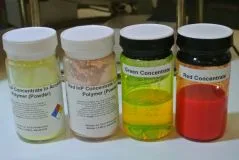
A lot of the conversation about quantum dots at Display Week revolved around the European Commission’s rejection of their own technical committee’s recommendation that cadmium-based quantum dots continue to be exempt from prohibition as a dangerous substance.
Initially, this generated some angst in the cadmium crowd, and some jubilation in the non-cadmium (that is, indium phosphide) crowd. But a concensus soon emerged that the EC’s rejection was based on one minor technical and one procedural matter, and then the technical committee would certainly correct the minor issues, after which the exemption would be continued. EC exemptions are often based on no alternative solution being available, so the issue revolved around the current availability of indium phosphide. However, indium has been added to the EU’s list of hazardous substances. It was generally regarded as irrelevent to regulators that neither cadmium or indium is biologically available when encased in a quantum-dot shell, but that other issues would prevail.
Nanosys has a fallback position with indium phosphide if cadmium quantum dots are regulated out of any of their markets…
Nanosys, which won the award for best small booth at the show, had three side-by-side TVs that clearly showed why indium phosphide quantum dots are a poor substitute for cadmium. The typical conventional LCD-TV with white-LED backlighting Nanosys had in its booth had a measured color gamut of less than 60% of rec.2020, a luminance of 500 cd/m², and a power consumption of 130 watts. The same model of TV modified with blue LEDs and a cadmium quantum dot sheet in the backight measured greater than 90% of rec.2020, 400 cd/m², and a power consumption of 130 watts (with the original color filter array). And another set of the same model with an indium-phosphide quantum-dot sheet measured about 75% of rec.2020, 350 cd/m², and 130 watts.
 …but the company makes it very clear which is technically superior.
…but the company makes it very clear which is technically superior.
Clearly, if your goal is to get close to rec.2020, indium phosphide is not the way to go. Subjectively, the difference between the cadmium-enhanced TV and the standard model was dramatic. The difference between the indium-phosphide-enhanced set and the standard one was visible, but sufficiently subtle that consumers might not be strongly motivated to pay a premium for it.
Nanosys Corporate Communications Manager, Jeff Yurek, wanted me to know that Nanosys has reached a level of manufacturing volume that EPA required it to submit a pre-manufacturing notice, which was accepted. He also announced a follow-on investment from Samsung Venture Investment Corporation. The new funds will be used to expand production capacity “as demand for Nanosys technology for displays grows rapidly.”
Also at Display Week, Nanosys parter 3M Display Materials and Systems Division showcased LCDs in several sizes with color gamuts of up to 93.7% rec. 2020 color gamut. Among the demos was a 4K monitor with 93.7% rec.2020, “one of the largest known color gamuts in an otherwise commercially available 4K LCD monitor.” (We have a video interview with 3M at 3M Adds QDs to Monitors and Helps Auto Makers Use LCDs and the company spoke at the investors conference – Nanosys Wants 25% of the QD Market)
3M showed a 94% rec.2020 demo, as did each of the serious quantum dot players. Going higher requires color filter arrays tuned to the quantum dot emissions. Credit: all photos : Ken Werner
If Nanosys and 3M are among the leading QD companies, Quantum Materials Corp. (San Marcos, Texas) is one of the hopefuls. Although not exhibiting at Display Week, QMC staffers were talking to media types in the hallways. I guess this is what justified the company saying in a June 1 press release that it “today launched their new QDX™ class of high-stability cadmium-free quantum dots at the Society for Information Display (SID) Display Week 2015 International Symposium in San Jose, CA.” The release continued, “QDX™ Quantum Dots have been tested to withstand heat resistance to 150 degrees centigrade for four hours with no oxidation performance degradation in an open air environment.” When I asked, QMC PR person Art Lamstein told me the company was in a “pre-revenue” stage.
In addition to the company’s original cadmium-based quantum tetrapods based on a Rice University patent, the company is now also making indium phosphide dots based on a Bayer patent the company purchased in 2014.
QD Vision was exhibiting real live (shipping) products usings its IQ Color linear quantum-dot element. Among them were a Philips 29-inch monitor, a TCL 65-inch TV, and a Hisense 65-inch curved TV. This is the first curved quantum-dot TV, said CMO John Volkmann, and it uses one edge-light and one IQ Color element on each of the left and right edges.
I asked Volkmann if he was concerned that an increasing percentage of TV sets are using direct backlighting for local area dimming, and can therefore not use QD Vision’s linear array. His answer: “There will be a lot of edge-lit TVs made for the foreseeable future.” He also said the company was looking at other form factors. As previously stated, the company is working on a QD-on-chip approach and is closer than their competitors. There was 94% rec.2020 demo in the booth. To get higher than that, Volkmann said, we need wide-gamut color-filter arrays as well as good quantum dots.
Volkmann was confident that cadmium would remain legal in the EU and did not mention any fall-back materials.

